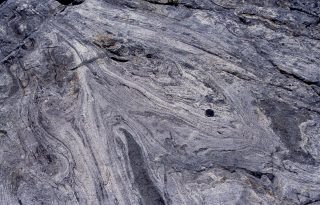The formation of continental crust — just add water!
by William J. Collins
Humans live on the “third rock” from the sun, Earth, where average surface temperatures are about 15oC. Because water only exists between 0-100oC on the Earth’s surface, water is the dominant form of H2O on our planet. Venus and Mercury are too hot to have liquid water, so it only exists as vapour, and Mars is too cold. Given humans are approximately 70% water, it becomes obvious why we thrive here and nowhere else in the solar system. Indeed, all forms of life on Earth require water.
With few exceptions, humans also live on large landmasses, which we call continents. Therefore, understanding the formation of continents helps us understand why humans evolved and flourished. Without continents, the Earth would be covered by oceans, with a few islands dotted here and there, like the Pacific Ocean is today. The floor of the ocean is a dense rock called basalt, and it is the dominant rock of the outer shell of the Earth, called the crust.
Basalt crystallises from molten rock derived directly from the underlying mantle. It is the dominant material forming the crust of all the “rocky” planets, including Mercury, Venus, Earth and Mars. However, only Earth has formed a “second generation” crust, which is the continental crust. Continental crust is much more buoyant than the basalt of oceanic crust. It is so buoyant that it “floats” on the mantle and rises above the oceans to form land. Without continental crust, life would not have evolved beyond the most primitive lifeforms. Certainly, humans would not exist.
This “second generation” crust that forms continents has grown through time. Like life itself, it has evolved. The first crust of the Earth was dominantly basaltic, like the other rocky planets, but over the following billions of years, 4.5 billion in fact, about one third of the Earth’s surface was converted to continent.
The continental crust is dominated by huge volumes of granite and their origin plays a dominant role in its construction and growth. Geologists argue about how quickly continents have formed, but the process essentially requires the conversion of basalt to granite. How that happens is the essence of our recent paper in Nature Geoscience. We agree with many other scholars that continent formation proceeds mostly by melting of basaltic rocks, but we consider that most have neglected the essential role of water in the process.

How does water melt basaltic rock? Water is a “universal solvent” that dissolves more substances than any other liquid. For example, if you soak a dirty frying pan overnight in water, most of the dry, crusty, baked on food actually dissolves, so you can easily scrub the frypan next morning. Well, in the deep crust where temperatures hover between 600-800oC, water has a similar effect. It dissolves that crust.
For the last 40 years, most geologists have thought the source of water for melting basalt to produce continents was stored within the crystal structures of minerals hosted in rocks within the deep crust (20-30 kilometres below surface). Common hydrous minerals in the deep crust usually contain 2-4 % water. According to this paradigm for continent formation, when the deep crust melts, these minerals release their stored water, resulting in melting of that crust and the formation of granite magma.
However, the amount of melt produced is limited by this process, because hydrous minerals are not abundant in the deep crust. Typically, the total amount of water in rocks from the deep crust is approximately 1% or less. Accordingly, to produce the large volumes of granite required to form continental crust, additional heat from the mantle was considered necessary, raising temperatures to 850-1000oC. By contrast, we argue that melting commonly occurs at much lower temperatures, more like 750oC.
The shift in the paradigm comes from realising two things: (1) large volumes of water is delivered to the base of the crust by processes in the underlying mantle; (2) this water effectively dissolves the basaltic crust to produce voluminous granite. Through advanced thermodynamic modelling, we show that the addition of just 2 % water to the deep crust, at about 750oC, increases the amount of melting from a trivial 5% to 20%, at which stage the molten rock (magma) is sufficiently buoyant to rise higher into the crust to cool into granite, forming continental crust.
Furthermore, we show the supply of water in any locality lasts as long as the Earth’s tectonic plates converge on each other, by a process called subduction. Subduction involves the sinking of the oceanic plate deep into the mantle, and can occur in one place for millions of years. The sinking plate carries seawater, which becomes trapped in the crystal structure of minerals, but that water is released as the plate sinks to approximately 100 km below the Earth’s surface. As long as subduction occurs, water is released and is delivered to the base of the crust, melting pre-existing basaltic rock to form granite magma. As it rises and cools, the granite magma crystallises to continental crust.
Ultimately, the water may be released from the rising magma and reaches the surface along with lava in volcanic eruptions. The extremely dangerous volcanoes of the Pacific “Ring of Fire” are explosive because they are expelling this water, as we saw tragically in New Zealand last year, but such volcanic eruptions are the “end game” of the continental forming process.
Contact person: Prof. Bill Collins, Earth Dynamics Research Group, Curtin University.
Relevant publication:
Collins, W.J., Murphy, J.B., Johnson, T.E., Huang, H.-Q., 2020. Critical role of water in the formation of continental crust. Nature Geoscience, 13, 331–338. https://doi.org/10.1038/s41561-020-0573-6
